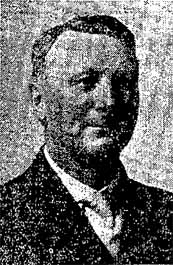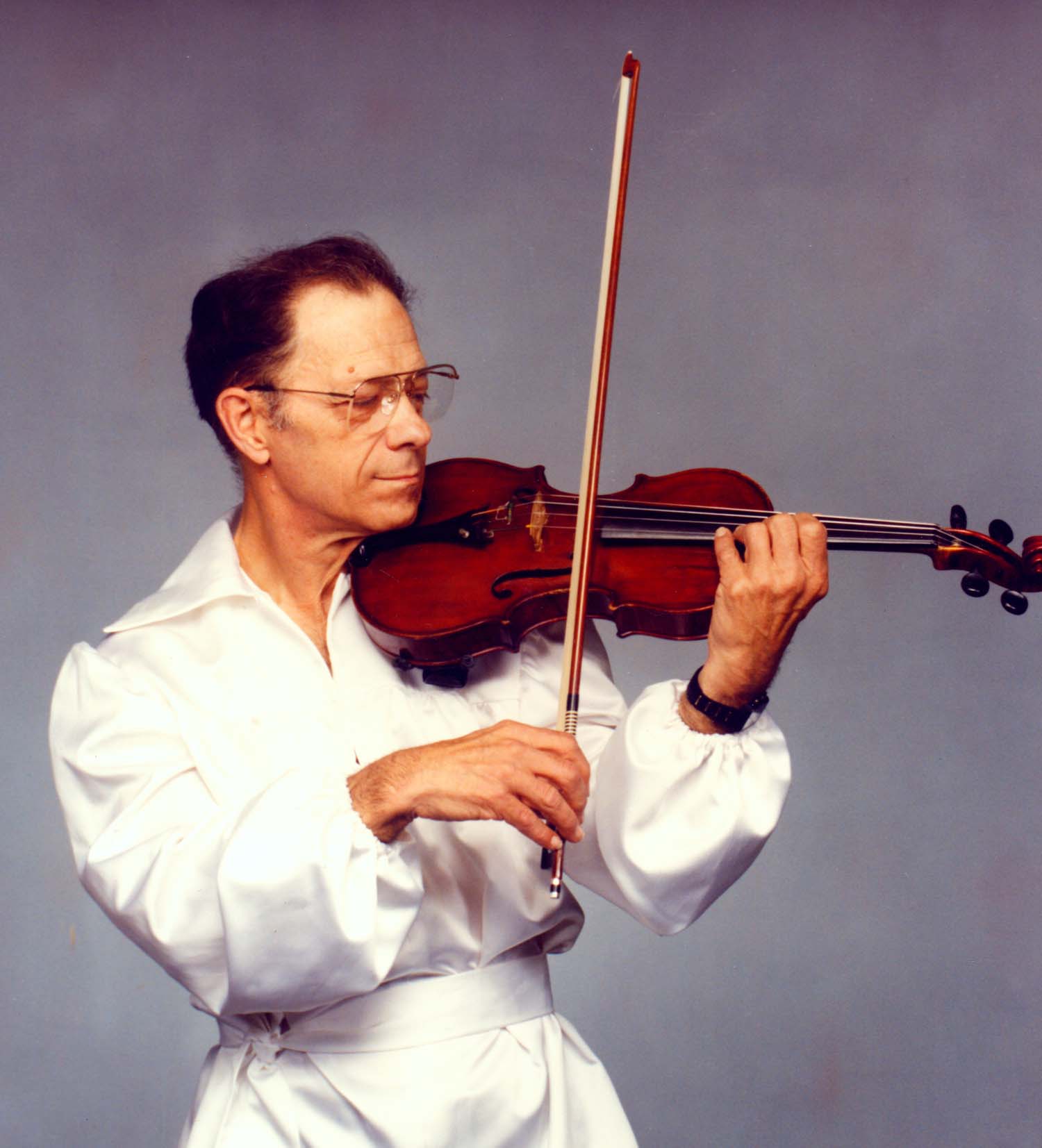H. E. Blasier - Williamsburg's Violin Maker
By Rita McDonald

H. E. Blasier
H.E. (Herbert) Blasier, son of Edward and Esther Hugunine Blasier, was born August 1, 1859 in York Township, east of Williamsburg where he attended Thompson Country School until 1873, when the family moved to Marengo. He graduated from Marengo High School in 1875. The family then moved to Iowa City where H.E. and his sister attended the State University of Iowa. H.E. graduated with an engineering degree in 1882. He married, taught school for two years, opened a business in Blairstown and in 1886 moved to Williamsburg where he opened a jewelry and watch repairing business. In his first few years in Williamsburg his business moved to three different sides of the square. In 1889 he built his own building at 209 West Welsh, where he ran a prosperous business selling jewelry and books and repairing watches. Blasier was recognized as a highly skilled workman in Eastern Iowa. H.E. was also a very skilled marksman in rifle shooting, winning many contests in the state. His skill in watch repair was notable, supposedly superior in this part of Iowa. Also notable was his fairness in trade, never known to exploit a customer. In 1914 Blasier assisted his son, Herbert, in the construction of the first wireless station in Williamsburg. According to the Journal Tribune the wireless station was one of the best equipped amateur stations in Iowa. A securely guyed 100’ steel pole rose from the station and from the top it was strung with a web of wires or antennae which connected to a secondary pole. The whole network was wired into the second floor over the Blasier Jewelry Store. Herbert and co-worker Edwin Jones made nearly all the equipment and supervised all the construction work. They were equipped with headsets and picked up messages as far away as Washington, Florida, Louisiana and Colorado.
In the late 1800’s, H.E. became interested in violin making. His degree in engineering and the mathematical skills enabled him to determine the requirements of a perfect violin. Violins became his passion. He read every technical work available on violins and also became familiar with the works of Stradivarius. Blasier reasoned that there was a reason that of the thousand violins Stradivarius made, many were of poor quality and sound and some were excellent. He was able to take violins apart, measure them with a caliper he had developed and make adjustments to enhance the sound of the violin. After years of testing and experimentation, Blasier felt he had scientific means to produce the perfect violin. The best information we have provides us with Blasier’s first violin being made in 1900.
Sometimes it’s hard to glean truth from old newspaper articles. It’s a well known fact evidenced by reading through old newspaper obituaries that much information was painted “rosy” and was not necessarily so. However, when matching up newspaper articles with information received from Brian Florescu (see below), we can be fairly sure that H.E. Blasier certainly was an excellent violin maker.
From the Journal Tribune, November 6, 1913
H.E. Blasier is by far the happiest man in Williamsburg. … Last week Maud Powell, the world’s greatest woman violinist, filled an engagement in Cedar Rapids. Mr. Blasier went to hear her and of course he took with him his latest and best violin, the one upon which he was sure his best work had been lavished. Herbert knew that the instrument was a fine one and he was willing to submit it to the judgment of a real artist, so he succeeded in securing an appointment with the great performer, a favor seldom granted. Miss Powell used in her concert work a $10,000 “Strad” and she will rarely condescend to even examine a new instrument. But in this instance she did show a willingness to scrutinize the violin made in Williamsburg. She held it up to the light, she peered through the matchless “f” holes on the top of the instrument, she expressed admiration at the faultless purfling on the borders of the shell and she noted again the exquisite harmony in the design of the instrument. She reached for her own bow, the same one that so tenderly, yet forcefully brings out the rich tones from her famous “Strad, and, drawing it across the Williamsburg violin, her quick ear at once caught the smoothness and volume of the witching sound, she rendered some simple selection and then another; she looked the instrument over, she tried it again, and then she spoke the words that account for the happiness of the maker. She said that it was unquestionably the finest instrument she ever touched, and this assertion was made stronger by saying that she tried the violins of the world’s best makers, both at home and abroad, she openly declared that she would be delighted to have such an instrument to use in her concert work. The wish made the thrill come to Mr. Blaiser and he at one presented the artist with the violin with the permission to use it in her work as long as she pleased. She was delighted with this and it is worth something for Williamsburgers to know that the great Maud Powell is now using, through her own choice, a violin that was made right here in our own town.
In 1913 at the gathering of the American Guild of Violinists in Chicago, a Blasier violin was entered in a “test” with the best violin makers in the United States. Blasier’s violin was the only instrument tried out that was not criticized. In June of 1915, Blasier’s violin won first place at the annual National Violinists Guild meeting in Chicago. Blasier exhibited six instruments and the one that won the honors was Number 27, the most recent violin Blasier had completed. The judges placed it far ahead of any modern instrument and several of the players rated it ahead of works of the old masters. By this time, in 1915, H.E. had made 27 violins and was teaching Ed Collins, rural Williamsburg, to make violins. Ed, graduate of Augustana College in Rock Island, Illinois, was a fine violinist and by 1916 had made three violins.
From the Journal Tribune, May 26, 1927
His violins have been pitted against the most celebrated of the “Strads” – and the palm was given to the instrument made right here in Williamsburg.
Francis McMillan played a Blasier violin in his concerts – and admitted that he never played a better instrument. Maud Powell carried two of the Blasier violins for years, playing them in concerts upon which trained the greatest musical critics of the country, and all of them marveled at the tones of the instruments made by a son of the prairie, and in a town not widely known. And when Williamsburg comes into the full light of the fame to which she is so fully entitled, it will be plainly owing to the fact that here lived and worked a man who made violins far more perfect than the best of the shells ever made by Antonio Stradivarius, the craftsman who made the Italian city of Cremona the synonym for a violin representing the acme of perfection.
Mr. Blasier has standing orders for violins from all parts of the country. Men who know something about the excellence of these instruments never quibble about the price – and every instrument that “Herb” sends out is a gem of unexcelled workmanship, and its tones are admittedly perfect.
According to a 1924 Cedar Rapids Gazette article, by the age of 65, Blasier had made 58 violins. In 1927, after 42 years of running his business in Williamsburg, H.E. Blasier moved to Cedar Rapids where he continued his business of making violins. The former book and jewelry store was then used as a pool room. In 1929 the Blasier building was leased by the Ben Franklin chain store. H.E. Blasier died in December of 1930.
During research done for the sesquicentennial celebration we became aware of the Blasier violin story. Shirley Steffen offered the use of a Blasier violin, purchased in Williamsburg, that was still in her family’s possession. It was the first Blasier we had seen. In 2008 Shirley’s son, Gus, found a Blasier violin for sale on-line. Negotiations were made and Blasier violin #12, made in 1908, is finding its way back home to Williamsburg. Gifted to Ron and Arlene Holden as a “thank you” for their tireless work on the Williamsburg Sesquicentennial, the violin has been gifted back to the Williamsburg Historical Commission to be displayed in the Williamsburg Historical Building on the square in Williamsburg. Gus futher reports that he has found information about another Blasier violin (number unknown) sold this past fall in Cedar Rapids. It was one of two violins owned by the Frances Blood Estate, the other violin being a Stradivarius.
The previous owner’s son, Brian Floresco, was kind to send us the following information on Blasier #12:
My father, Leo Florescu was an accomplished classically trained musician. Even in his golden years he humbly thought of himself as a student of music. He was a collector, appraiser, repairer, composer, teacher, pianist and Gypsy violinist of Romanian descent. All this was in addition to being a father of seven children, loving husband and one of the original workers at the ALCOA Riverdale, Iowa works, retiring in 1989 after 41 years. Leo passed on in 2006.

Leo Florescu with Blasier # 12 Violin
He played first chair violin in various orchestras throughout his life, including St. Ambrose College, Augustana College, Blackhawk College, local churches and chairs as well as the Quad City Banjoliers in later years. He was also associated with the Tri-City, and later Quad City, Symphony as patron of the arts, performer, student and teacher.
The “old number 12” was his primary instrument for both practice and public performance for over 25 years. It was purchased at Tubbs Antiques, Davenport, Iowa in the 1970’s. It was once repaired by Victor Petersen. Its loud clear tone was unmatched.
Blasier is listed in the 1925 book, An Encyclopedia of the Violin, by Alberto Bachmann, published by D. Appleton & Co. NY/London, and the 1966 De Capo edition of the same title. The Library of Congress lists this encyclopedia as the definitive work of the violin. He was recognized as an American violin maker on page 49 of the Library of Congress #65023406. Blasier is listed on page 151 in the 1968 publication of the Encyclopedia of Violin Makers, Volume 1 A-K, by Karel Jalovec, published in London by Paul Hamlyn.
The “old number 12” modeled in the Guarneri del Gesu style, was appraised by David Pope, Davenport, IA, in 2007 at $1200-$1400. Mr. Pope is a highly regarded musician of the quad City Symphony Orchestra as well as the appraiser and repair person for many throughout the world. He may have more reference resources for Blasier and his works.
Dad was quite a collector but nothing compared to his love for “old number 12”. We, of the Leo Florescu estate, are very pleased and joyful of “old number 12’s” latest chapter in history. May good fortune follow you and your works!
Credit and Source
Published: Iowa County IAGenWeb Website, 11 Jan 2009. Copyright © 2009 by Rita McDonald. All rights reserved.
Repository: Photos/digital scans at the Williamsburg Historical Commission